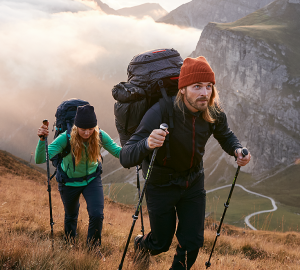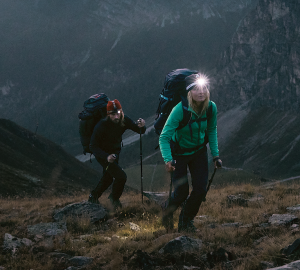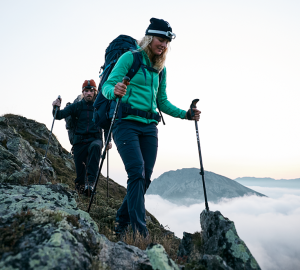When you hear Peru the first thing coming to your mind is the famous Inca city of Machu Picchu, but that doesn’t do justice to this marvelous country. There’s so much more to experience and witness – in the following we’ll report about an adventurous trekking tour in Colca Canyon – an (almost) unspoiled paradise in the Andean nature.
Hardly anybody doesn’t know the Grand Canyon in Arizona, but who’s familiar with the Colca Canyon in Peru? Not many! And yet, Rio Colca – like Colorado River – did work pretty hard too in the course of time and eroded the massive Colca Canyon. The canyon’s rim falls 1,200 meters deep to the very ground. Close to the canyon – in the small village of Pinchollo – is the starting point of a highly varying trekking tour across the Andes.
Also interesting: Trekking Tips – Never been on a trekking tour? The 5 most common beginner’s mistakes and how to avoid them
Cruz del Condor
Before the five-days-trip begins, a special show at the edge of the canyon awaits you. In the early morning, huge condors lift off at Cruz del Condor with the first thermal winds. With a wingspan from 2 to 3 meters the largest flying land birds are hovering high above the canyon. With the elegance of those flying giants in mind we are ready to lift off for our trip.
1. Stage: Pinchollo – Rio Colca – Madrigal
As soon as the last of Pinchollo’s houses is out of sight the way goes steeply downhill towards Rio Colca. Every now and then the typical terraces appear next to the way, which – in some cases – were built centuries ago by the native inhabitants of the canyon, the Collaguas, and are still used by their descendants.
At the bank of the river we have the good fortune – the chain bridge is sound, and we’re not supposed to cross the water by jumping from one slippery rock to another.
The rest of the trail runs quite comfortable through the valley and, in the distance, the first stage’s destination is already within sight. After a decent climb we pitch our tents in the remote mining-city of Madrigal, which was formerly occupied by the mining company’s workers.
2. Stage: Madrigal – Puya Raimondii – Laquipaya Conyon
The next day starts early and we are leaving the camp at 6 a.m. On our today’s bucket list there’s 1,300 meters to climb and one particular highlight to discover. After about four hours we can look at the first Puya Raimondii in Laquipaya Canyon.
Also interesting: How to pack your backpack – the 5 most common mistakes when packing and how to avoid them
The Puya Raimondii is an extremely rare species of bromeliad (reaching up to 12 meters in height), which can only be found in Peru, Bolivia, and in northern Chile. The Queen of the Andes blooms for the first (and only) time after 70 to 100 years of growing – afterwards it simply dies away. In Laquipaya Canyon you can find several hundred of those unique plants.
By now we’ve reached an altitude of 4,600 meters and our pace has measurably decreased. Anyway, after three hours of hiking we pitch our tents next to a spring. Fortunately, there’s some combustible material near by to start a camp fire to cook and heat ourselves up. During nighttime it gets that cold that the spring’s water is completely frozen the next morning.
3. Stage: Mountain Pass – an Inca’s Trail to Tocallo
After a short and chilly night, we’ve to get up early. Our today’s destination is the outlying small village of Tocallo with a population of only around 50 people. Before we make it there, we’ve to climb up again – to an altitude of 5,010 meters. The landscape becomes more and more barren, yet, there’re lamas and alpacas grazing in this forbidding place all year. Though breathing is quite hard now the stunning view is worth the effort. Finally, the narrow trail, leading to the other mountainside, appears in front of us.
Interesting too: Cycling in Bangkok by night – To JJ Green Market and back again by bike
To our great relief the ancient Inca trail now leads downhill. Shortly after a few meters in height the headache lessens and the area surrounding the trail turns green again. Between the blooming bushes we’re now looking for the right way until, suddenly, we’re standing in the village of Tocallo (3,800 meters). There we’re welcomed warmly and with curiosity. Despite sleeping in our own tents this night we share our dinner – boiled sweet potatoes with butter and salt – with a local farmer in his hut. As token of gratitude we brought some salt and sugar as a present.
4. Stage: Sangalle Oasis
Today’s start is quite late – at 8 o’clock. We slept splendidly and can start the fourth stage well recovered. Admittedly, 7 hours of walking lay ahead of us but with enough oxygen that’s hardly an issue.
Interesting too: 7 Reasons why you should go on an adventure trip instead of a package tour
We’re really looking forward to our today’s final stop – Sangalle Oasis. And, indeed, after three hours of walking downhill we discover – like in a fairy tale – an idyllic oasis at the bottom of a ravine. Palm trees sway in a slight breeze, the climate nearly appears tropical, and in a pool there’re kids playing. The unexpected amount of civilization is overwhelming but for the night we find ourselves a quiet place under some palm trees.
5. Stage: Climbing the Canyon up to Cabanaconde
The next morning, we use some spare time to enjoy the oasis and relax – after all, this is our last day. Anyway, before there’s time to say goodbye we must follow a steep way out of the canyon first. Since we are in good shape, we climb the 1,100 meters of height at a great pace and reach the top within less than two hours.
Interesting too: Backpacking insights – 5 items to make a coach trip more comfortable
After a short walk to Cabanaconde we’re on the bus to Puno at Lake Titicaca. Everything feels a bit surreal now – wistfully we wave towards our guide thankful for this impressive and diversified tour.







